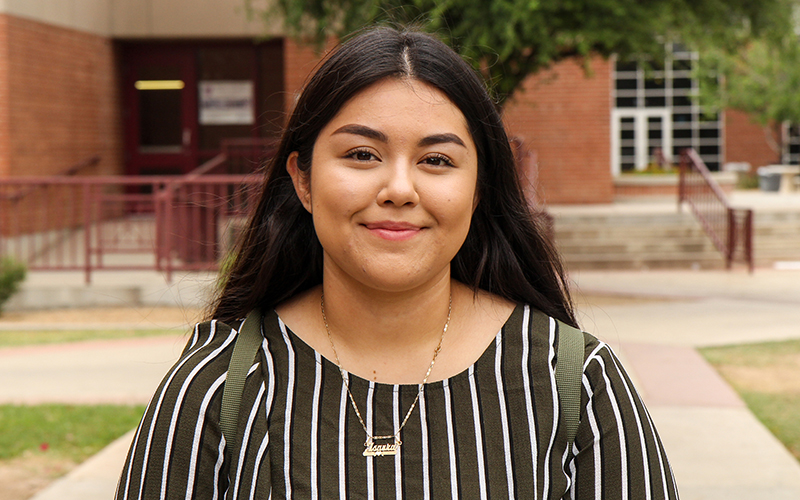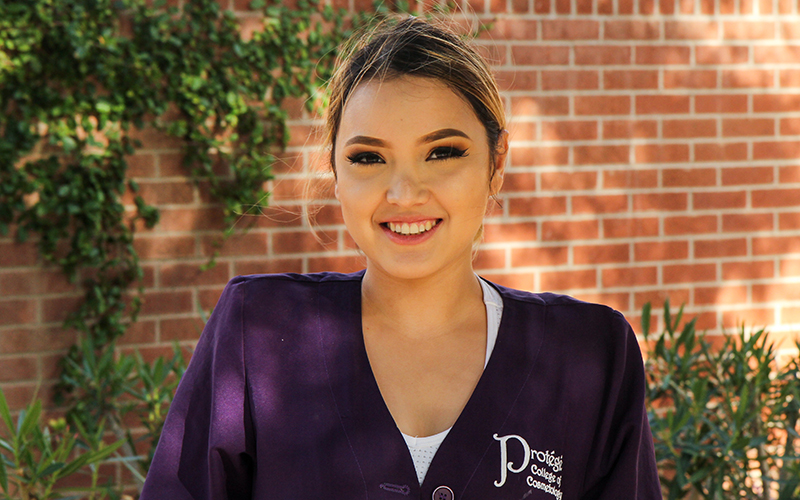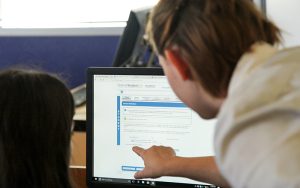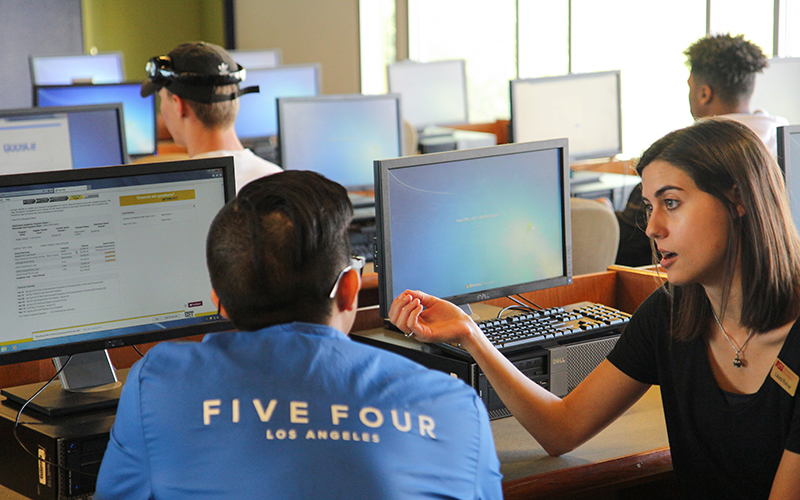PHOENIX – The Phoenix Union High School District has increased the number of students going to college – many of them the first generation to do so – through an innovative program that takes advantage of free financial aid and assures low-income youths that college is a realistic goal.
Arizona students left more than $65 million in free federal aid unclaimed last school year because they did not fill out the required federal form, according to a 2017 NerdWallet report.
The No. 1 reason, according to district officials, is that many students don’t know that financial aid is available – especially first-generation college students, who need financial help the most. Others find the required student aid form, called FAFSA – Free Application for Federal Student Aid – too complex. But completing the FAFSA form is the only way to receive federal grants, loans and work-study programs for college.
A program created by the district with the Be a Leader Foundation is making it easier for students to successfully complete the financial-aid application rather than relying on family members who have no experience. The program also targets students starting with their freshman year in high school to keep assuring them college is within their reach.
As a result, more Phoenix Union students are going to college, school officials said. Fifty percent of Phoenix Union students went to college in 2017 right after high school, a 4 percentage point improvement over the previous year, according to data from Phoenix Union. The district said it’s the largest percentage increase ever in one year.
Officials at Phoenix Union, which has suffered historically high dropout rates and low graduation rates, said it is now closing in on consistently meeting the state average of 53 percent moving on to college.
Isaura De Luna, a senior at Metro Tech High School who will attend Phoenix College in the fall, agreed that first-generation college students have a harder time with the FAFSA form and other technicalities.
“It’s harder when your parents don’t know about college and how it works, and the process and the requirements,” she said.

Isaura De Luna, a senior at Metro Tech High School, will be attending Phoenix College in the fall. De Luna said she would not be going to college if it weren’t for the help of Phoenix Union High School District. (Photo by Stephanie Morse/Cronkite News)
She also had some personal problems her junior year that threw her off course, but regular reminders from the district to fill out her FAFSA, and one-on-one help, kept her on track.
“Honestly, I don’t think I would be going to college if it wasn’t for their help,” De Luna said.
Phoenix Union’s FAFSA program, now in its second year, is being watched by other school districts around the state that have high enrollments of low-income students, said Dolores Ramirez, the post-secondary articulation specialist for the district. If it can work for Phoenix Union, where 81 percent of students qualify for subsidized lunches, the hope is that it will work for other such districts.
“Financial barriers will be some of the biggest barriers for them to enroll in a higher education institution,” said Karla Robles, chief strategy officer for the Be a Leader Foundation. “That’s why it’s extremely important for them to get all the money they can and to complete the FAFSA. The majority of them will qualify for Pell Grants, which don’t have to be repaid.”
The new program requires commitment from advisers and students.
“You can’t just have a FAFSA night with a PowerPoint,” Robles said. “It’s sitting down with them, filling out the forms, calling them in and tracking. It’s telling them, ‘I’ll help you do this.”’
Advisers nudge students who need to complete the form and set up one-on-one appointments to help them finish it.
The district also tries to increase college awareness with students who may not envision college in their future. These conversations often are different at Phoenix Union because of the students’ backgrounds, district officials say.
“We’re working with mostly first-generation college-bound students and a high minority population so students have not necessarily had college exposure,” Ramirez said. “They’re not having those conversations at home. It’s not that their parents don’t care or don’t want their kids to go to college, but parents may not have college experience and knowledge.”
Parents of more affluent students have probably gone to college and are more likely to understand student grants and loans and to know what steps are involved, Ramirez said.
“Many kids in other school districts had their parents talking to them about college for 18 years,” Ramirez said. “We have four years to make up for 18 years.”
Britania Montano, another senior at Metro Tech High School who’s headed to Phoenix College in the fall, agrees that the district’s FAFSA program works.

Britania Montano, a senior at Metro Tech High School, will be attending Phoenix College in the fall. Phoenix Union helped her fill out the FAFSA and pick a college. (Photo by Stephanie Morse/Cronkite News)
“They made everything two times easier for everyone,” she said. “I wouldn’t even know how to fill out a FAFSA form if they wouldn’t have guided me through it.”
In 2017, the first full year of the program, 632 more students than the previous year filled out the FAFSA form, a 26 percent increase over 2016, according to data collected by Be a Leader.
Another record is in the making. As of May 5 in the 2017-18 academic year, 2,581 students filled out the FAFSA, with about 463 other students still in the process, according to new data. The district’s FAFSA completion rate was almost 50 percent this year, nearing some other districts in more affluent areas in metro Phoenix, including Scottsdale and Chandler, which regularly have 50 to 60 percent of students filling out the FAFSA form.
Ramirez said more Phoenix Union students are now going straight to universities instead of community colleges. In the 2016-17 academic year, 112 more Phoenix Union students enrolled at Arizona State University compared with the previous year, a 22 percent increase, according to data from the foundation. Historically, students who enroll in four-year universities have higher degree program completion rates than students attending community college.
Raising personal expectations
A big part of getting high school students to move toward college is about an attitude adjustment toward higher self worth and expectations, district officials say.
Phoenix Union created posters about FAFSA targeted at teenagers, with sayings such as “Stop liking photos and fill out your FAFSA.” Others featured Phoenix Union graduates on college campuses with the headline “I am what college looks like” to encourage high school students to envision themselves at college.
Phoenix Union recently expanded the efforts with posters that target freshmen and sophomores with information about what classes they need to take to be college eligible and what financial aid opportunities are available at Arizona universities and community colleges.
Starting last October, Phoenix Union freshmen began receiving letters from ASU saying, “You are on track to go to college.” Sophomores and juniors receive follow-up letters indicating where they are on the path to college.
The district also started bringing in representatives from the three state universities, as part of the Tri-University tour, to start recruiting juniors rather than waiting until they are high-school seniors.
The effort extends beyond students, Ramirez said.
“We’re educating counselors, parents, students, teachers, everyone,” she said.
Students De Luna and Montano started filling out their financial aid forms at one of Metro Tech’s FAFSA drives. The events, organized under the new program, take place at every high school in the district and include volunteers from ASU, local community colleges and the Be A Leader Foundation to help students fill out the form.
Students who didn’t complete their FAFSA during the event make appointments with counselors and FAFSA experts to get individual help and clear up any confusion.
“After that the FAFSA went through and it was complete,” De Luna said.
Idea spreads, but obstacles remain
Other local school districts are taking notice. Tolleson Union High School District has recently partnered with the Be a Leader Foundation to do implement a similar program, foundation leaders said. Other schools in the state are also starting to do FAFSA completion drives during the school day, like Phoenix Union does.
“We know that it’s easier when the students are in front of us instead of having them come back at night, because they don’t tend to come back at night,” Ramirez said.

Brielle Giesemann, a High School Coordinator for the Be A Leader Foundation, helps a student navigate the FAFSA during a FAFSA drive at Betty H. Fairfax High School on Feb. 9. (Photo by Stephanie Morse/Cronkite News)
The program has also garnered some national attention. Phoenix was one of 22 cities in the nation to win a $55,000 grant from the National College Access Network in 2016 as a part of the organization’s FAFSA completion challenge. This school year, Phoenix was one of eight cities to receive an additional $25,000 based on its large increase in FAFSA completions and success at taking “an especially strategic approach.”
No matter what they do, Ramirez said they still don’t reach every student with college potential. Some don’t want to make the effort, or are lured away from college by the necessity of a paycheck. Others don’t want to bother their parents for information on their federal income tax forms, or fear their parents may not have filed taxes. Some have immigration issues.
And there are a few who can’t be persuaded.
“Students think it can’t be true that the government is going to give me money to go to school,” Ramirez said. “It’s hard to convince students this is true.”
Camelback High School counselor Sarah Lawrence said students often come to her office who say they are homeless, or the sole provider for their family.
“It’s hard to say this is the most important thing when a student doesn’t know when they’re going to get their next meal or where they will be living next week,” Lawrence said.
And sometimes students just get sidetracked by making bad choices in high school, Ramirez said.
De Luna, the Metro Tech senior, can relate. She said she got kicked out of her mother’s house during her junior year, then lived with her boyfriend’s family briefly before she and her boyfriend moved into an apartment together. De Luna tried to make ends meet but eventually dropped out of school for about four months.
“Then rent was kind of high for us, so I had to leave school and work full time to have money for the rent and utilities and stuff like that,” De Luna said.
But near the end of her junior year, De Luna moved in with her mom again and returned to school, where she discovered the FAFSA program.
De Luna said her parents, who worried she would go a different way in life, are proud of her.
“I’m the first to go to college,” she said with a smile.
Follow us on Twitter.
